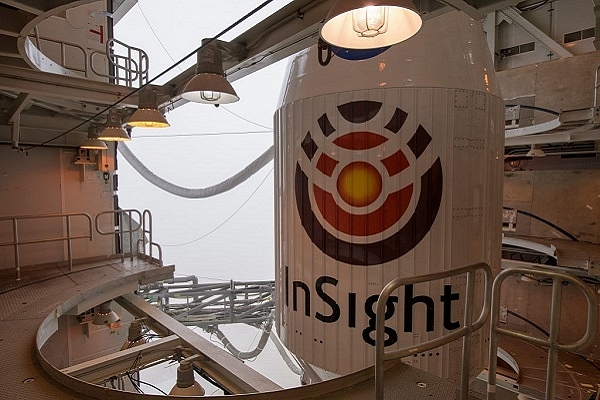Insta
Touchdown On Mars: NASA’s InSight Probe Lands On Red Planet, To Become The First To Explore Its Deep Interiors

NASA’s InSight Probe (Bill Ingalls/NASA via Getty Images)
After a six-month journey involving cruising 484,773,006 km at a top speed of 10,000 kmph, NASA's InSight spacecraft successfully landed on the Mars surface on Monday (26 November) at 11.52.59 am Pacific time (PT), NASA has announced.
Mission controllers at NASA-JPL received a signal from NASA’s InSight lander on the Mars surface via MarCO OR, the first CubeSats flying into deep space. Mars Cube One-A and Mars Cube One-B accompanied InSight on its journey to Mars and monitored the spacecraft from high above the planet.
InSight stormed through the thin Martian atmosphere, heatshield first, and used a parachute to slow down. It fired its retrorockets to slowly descend to the surface of the red planet, and land on the smooth plains of Elysium Planitia.
Following the landing, it also transmitted back the first picture of its new home.
InSight, which stands for Interior Exploration using Seismic Investigations, Geodesy and Heat Transport, will be the first mission to study the deep interior of Mars and take the planet's vital signs like its pulse, and temperature.
It will place a single geophysical lander on the planet to study the deep interiors. The terrestrial planet explorer will open a window into understanding the processes which shaped inner solar system's rocky planets - including our Earth, more than 4.5 billion years ago.
To look deep into Mars, the lander must be at a place where it can stay still and quiet for its entire mission. That's why scientists chose Elysium Planitia as InSight's home.
InSight in its quest to answer fundamental questions about the planets' formation will be aided by sophisticated geophysical instruments to detect the fingerprints of those processes buried deep within the interior of Mars.
The lander comes equipped with two science instruments which will conduct the first “check-up” of the planet, measuring its “pulse,” or internal activity, along with its temperature and “reflexes,” which is defined as the way the planet wobbles when pulled by the sun and its moons.
One of the two instruments is the Seismic Experiment for Interior Structure (SEIS), provided by the French Space Agency, with the participation of the Institut de Physique du Globe de Paris (IPGP), the Swiss Federal Institute of Technology, the Max Planck Institute for Solar System Research, Imperial College and the Jet Propulsion Laboratory.
The second instrument is the Heat Flow and Physical Properties Package (HP3), which was provided by the German Space Agency. Also, the Rotation and Interior Structure Experiment (RISE), led by JPL, will use the spacecraft communication system to provide precise measurements of planetary rotation.
Introducing ElectionsHQ + 50 Ground Reports Project
The 2024 elections might seem easy to guess, but there are some important questions that shouldn't be missed.
Do freebies still sway voters? Do people prioritise infrastructure when voting? How will Punjab vote?
The answers to these questions provide great insights into where we, as a country, are headed in the years to come.
Swarajya is starting a project with an aim to do 50 solid ground stories and a smart commentary service on WhatsApp, a one-of-a-kind. We'd love your support during this election season.
Click below to contribute.
Latest